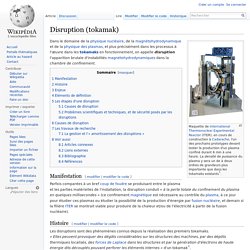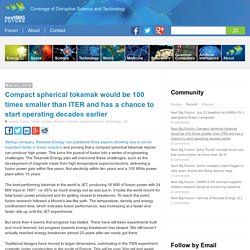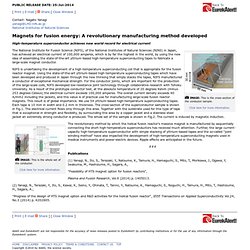

Tokamak etymology. ITER - the way to new energy. The world's largest Tokamak. La fusion nucléaire Documentaire. Disruption (tokamak) Un article de Wikipédia, l'encyclopédie libre.

Maquette de International Thermonuclear Experimental Reactor (ITER), en cours de construction à Cadarache, l'un des prochains prototypes devant tester la production d'un plasma confiné durant 6 min à une heure. La densité de puissance du plasma y sera un de à deux ordres de grandeurs plus importante que dans les tokamaks existants[1]. Dans le domaine de la physique nucléaire, de la magnétohydrodynamique et de la physique des plasmas, et plus précisément dans les processus à l'œuvre dans les tokamaks en fonctionnement, on appelle disruption l'apparition brutale d'instabilités magnétohydrodynamiques dans la chambre de confinement. Leur ampleur devrait augmenter avec la puissance des nouvelles générations de tokamaks.
Dans les conditions actuelles du savoir et de la technique, il semble impossible d'empêcher les disruptions dans les tokamaks, on s'oriente donc vers leur détection la plus rapide possible et leur gestion et atténuation. Compact spherical tokamak would be 100 times smaller than ITER and has a chance to start operating decades earlier. Startup company Tokamak Energy has published three papers showing size is not an important factor in fusion reactors and proving that a compact spherical tokamak reactor can produce high power.

This turns the pursuit of fusion into a series of engineering challenges. The Tokamak Energy plan will overcome these challenges, such as the development of magnets made from high temperature superconductors, delivering a fusion power gain within five years, first electricity within ten years and a 100 MWe power plant within 15 years. The best-performing tokamak in the world is JET, producing 16 MW of fusion power with 24 MW input in 1997 - i.e. 65% as much energy out as was put in. It holds the world record for total fusion power produced and for getting closest to breakeven. To reach this point, fusion research followed a Moore's law-like path. But since then it seems that progress has stalled. Tokamak Energy Progress to date SOURCES -World Nuclear News, Tokamak Energy, Wikipedia, Youtube.
ITER. An Eyre or Iter was the name of a circuit traveled by an itinerant justice in medieval England (a Justice in Eyre), or the circuit court he presided over,[1] or the right of the king (or justices acting in his name) to visit and inspect the holdings of any vassal.

The eyre involved visits and inspections at irregular intervals of the houses of all vassals in the kingdom. The eyre of 1194, was initiated under Hubert Walter's justiciarship to restore royal justice following the anarchy of Prince John's rebellion. Within two months, justices on eyre had visited every shire in England. The Articles of Eyre appointed local knights as coroners to record crown pleas to be presented to the justices. The motivation for this administrative reform was the need to raise money for King Richard I's reconquest of Normandy. The 1233 Eyre of Cornwall, provoked terror in the populace causing most of the population to flee into the woods.[3] Fusion Research Breakthrough: Controlling Fusion Heat.
By Raphael Rosen | *Science Daily Researchers from General Atomics and the U.S.

Department of Energy’s Princeton Plasma Physics Laboratory (PPPL) have made a major breakthrough in understanding how potentially damaging heat bursts inside a fusion reactor can be controlled. Scientists performed the experiments on the DIII-D National Fusion Facility, a tokamak operated by General Atomics in San Diego. The findings represent a key step in predicting how to control heat bursts in future fusion facilities including ITER, an international experiment under construction in France to demonstrate the feasibility of fusion energy. This work is supported by the DOE Office of Science (Fusion Energy Sciences).
The studies build upon previous work pioneered on DIII-D showing that these intense heat bursts — called “ELMs” for short — could be suppressed with tiny magnetic fields. [Read more here] Journal References: C. Related. Lockheed Martin's new fusion reactor might change humanity forever. Magnets for fusion energy: A revolutionary manufacturing method developed. 25-Jul-2014 [ Print | E-mail ] Share [ Close Window ] Contact: Nagato Yanagiyanagi@LHD.nifs.ac.jp National Institutes of Natural Sciences The National Institute for Fusion Science (NIFS), of the National Institutes of Natural Sciences (NINS) in Japan, has achieved an electrical current of 100,000 amperes, which is by far the highest in the world, by using the new idea of assembling the state-of-the-art yttrium-based high-temperature superconducting tapes to fabricate a large-scale magnet conductor.

NIFS is undertaking the development of a high-temperature superconducting coil that is appropriate for the fusion reactor magnet. The revolutionary method by which the helical fusion reactor's massive magnet is manufactured by sequentially connecting the short high-temperature superconductors has received much attention. Publications (1) Yanagi, N., Ito, S., Terazaki, Y., Natsume, K., Tamura, H., Hamaguchi, S., Mito, T., Morikawa, J., Ogawa, Y, Iwakuma, M., Hashizume, H., Sagara, A.
Fusion Energy: A Practical Guide [Infographic]